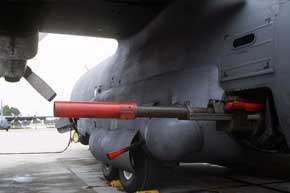
The AC-130's 105mm howitzer / DoD photo
Once you’ve declared that no U.S. combat boots will be on Libyan soil, you do the next best thing: send in aerial ground-pounders. After more than a week of high-flying B-2s, F-15s and F-16s, the Pentagon has begun flying a very different kind of warplane over Libya in recent days.
The A-10 Warthog (not its official name, which is the Thunderbolt II) and the AC-130U Spooky gunship, which boasts a fearsome 105mm cannon hanging out its side, are designed to turn enemy troops into red mist after destroying their armor. “I’m not going to talk about specifically how any of the weapons systems are being employed,” Vice Adm. William Gortney, director of the Pentagon’s Joint Staff, said Monday when asked how the two are now being used over Libya. “They’re combat aircraft, and they deliver a precision effect.”
The A-10 was the first aircraft developed by the U.S. Air Force to support troops on the ground, and is basically a flying GAU-8 Avenger heavy automatic cannon with wings. The seven-barrel gun fires close to 4,000 four-inch long shells a minute — 65 a second. It generally carries about 1,200 rounds, meaning it can fire nonstop for less than 20 seconds. From 4,000 feet, it can put 80 percent of its fire within a 40-foot circle. The gun packs a recoil with five tons of force, which actually slows the airplane down in flight.
In addition to a pair of relatively small-bore cannon, the AC-130’s real punch comes from its 105mm howitzer, which fires a round more than four inches in diameter. These side-mounted weapons employ high-tech radars, video and infrared devices to pinpoint their targets and destroy them with a single direct shot or so-called saturation fire. The venerable M-102 howitzer fired from the belly of the beast generally takes off with 96 rounds. The AC-130U tends to fly lazy orbits at about 10,000 feet, circling its prey — at night.


